Overview
The article "9 Essential UX Services for Tech Startups to Succeed" centers on a vital concern for many technology startups: the importance of user experience (UX) in achieving success. Many founders may feel overwhelmed by the myriad of responsibilities they face, and the struggle to meet user expectations can add to their stress. Ignoring the significance of UX can lead to frustrated users, decreased engagement, and ultimately, lost revenue.
However, by investing in comprehensive UX strategies—such as:
- User research
- Wireframing
- Usability testing
- Prototyping
- UI design
- Content strategy
- Accessibility design
- Performance analytics
- Ongoing UX consulting
startups can transform their challenges into opportunities. These services not only enhance customer satisfaction but also foster deeper engagement, paving the way for increased revenue. Numerous case studies and statistics throughout the article illustrate these points, providing a reassuring reminder that success is attainable. By prioritizing UX, tech startups can create a nurturing environment for their users, ensuring a brighter future for their business.
Introduction
In today's fiercely competitive digital landscape, tech startups are confronted with the significant challenge of crafting user experiences that not only draw in customers but also keep them engaged. This struggle can feel overwhelming, as the right mix of UX services often becomes the key differentiator that can elevate these businesses toward success. These services provide invaluable insights into user behavior and preferences, yet with an abundance of options available, how can startups discern which UX strategies will truly resonate with their audience and foster growth?
This article lovingly explores nine essential UX services that can empower tech startups to become customer-centric powerhouses, ensuring they shine brightly amidst a crowded marketplace.
RNO1: Comprehensive Branding and Digital Product Design Services
RNO1 understands the unique challenges faced by technology companies in today’s digital landscape. Many startups struggle to create engaging and user-friendly digital experiences, which can hinder their growth and connection with their audience. This is where RNO1 steps in, offering extensive UX services alongside branding and digital product creation tailored specifically for these businesses. By providing user interaction (UX) creation, user interface (UI) design, and performance marketing strategies, RNO1 empowers new ventures to craft cohesive digital experiences that truly resonate with their target audience, fostering growth and nurturing customer loyalty.
Investing in UX services is not just beneficial; it is essential for technology companies. Studies show that firms prioritizing design can generate 32% more revenue than those that do not. Imagine the potential of a well-crafted interface that can enhance conversion rates by as much as 200%, with efficient UX improvements leading to increases of up to 400%. This starkly highlights the direct relationship between customer experience and revenue growth, making it crucial for startups to focus on developing intuitive products and providing excellent UX services.
Consider the inspiring case of JobNimbus, which transformed its app and raised its ratings from 2.5 to 4.8 after a redesign. This significant improvement in customer perception and engagement illustrates the transformative power of UX design. RNO1 played a pivotal role in this journey, ensuring that the UX services were prioritized throughout the process. Similarly, Housing.com experienced a 20% rise in feature adoption following a revamp of their search capabilities, showcasing how focused UX enhancements can truly boost engagement.
Experts in the field emphasize the importance of a user-focused approach in UX services design. As one industry leader aptly stated, "Considerate UX layout can determine the success or failure of a new business." This underscores the necessity of frequent client testing and incorporating feedback to enhance and perfect products. Today’s branding trends for technology companies highlight the need for crafting individualized interactions and maintaining a consistent brand identity to build trust and recognition. Furthermore, prioritizing accessibility in UX is vital to ensure inclusivity and broaden the audience, ultimately enriching the overall experience.
In summary, RNO1’s commitment to comprehensive UX services not only meets the urgent needs of tech companies but also equips them for sustained success in a competitive digital environment. Together, we can navigate these challenges and create meaningful digital experiences that lead to lasting growth.
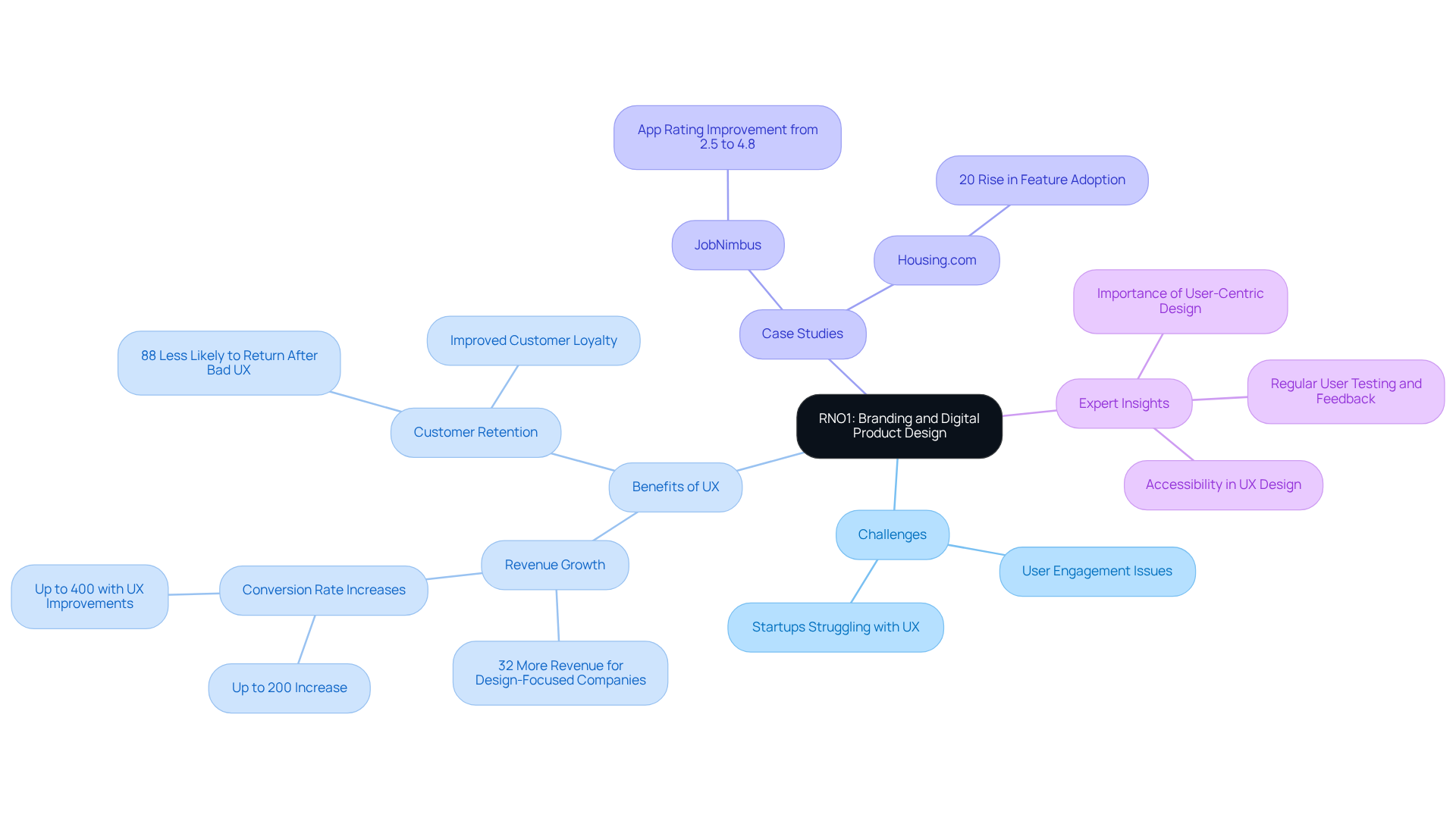
User Research: Understanding Customer Needs and Preferences
Participant research is an essential process that involves gathering insights about potential individuals through methods like surveys, interviews, and observational studies. This approach helps new businesses uncover pain points, preferences, and behaviors, allowing them to tailor their products to meet genuine consumer needs.
However, many founders may struggle to grasp the importance of this research, which can lead to misaligned products and frustrated customers. Effective audience research not only informs design choices but also significantly enhances overall product-market alignment. For instance, organizations with robust research practices are 1.9 times more likely to report improved customer satisfaction. This statistic highlights the vital role that research plays in achieving success, especially for technology companies.
Moreover, businesses that prioritize client satisfaction often witness substantial financial benefits; the anticipated ROI for usability and client interaction is projected to be 9,900 in 2024. This underscores that audience research is not just a step in the UX services process but an essential investment in the prosperity of technology startups.
Consider the successful case of Recora, which managed to reduce support tickets by 142% through insights gained from clients. This illustrates that understanding customer needs fosters better engagement and retention, ultimately propelling growth in a competitive landscape.
Additionally, with 88% of individuals less likely to return to a website after a negative experience, the importance of research in client retention cannot be overstated. By embracing audience research, tech startups can build lasting relationships with their customers, ensuring both satisfaction and loyalty.
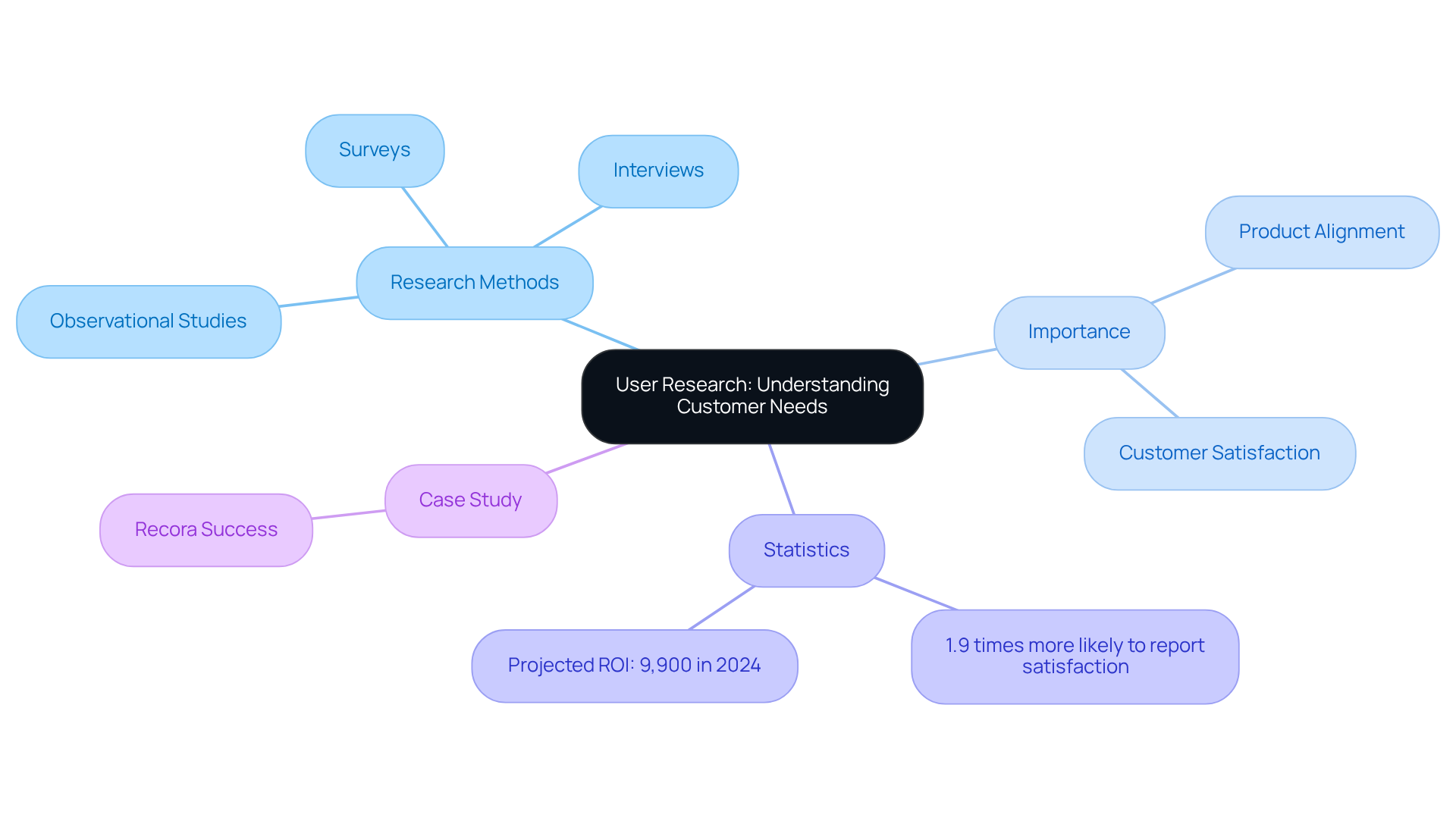
Wireframing: Visualizing Product Layout and Functionality
Wireframing often presents a challenge for tech startups, as it is a crucial stage in the UX development process. Many founders struggle with visualizing their product's layout and functionality early on, which can lead to misalignment and frustration later in the development cycle. This is where wireframing becomes a lifeline, allowing teams to create low-fidelity sketches or digital representations that outline the product's structure. By visualizing the interface early, teams can promote prompt feedback and make necessary adjustments, ensuring everyone is on the same page regarding the product's direction and user experience.
Establishing clear objectives for the website is essential, as it helps to focus on audience needs while maintaining a tidy and straightforward layout. This clarity prevents confusion and enhances user experience. Employing a grid system not only preserves alignment and balance across the design but also integrates visual hierarchy, directing attention to the most essential elements from the get-go.
Recent data underscores the significance of wireframing in enhancing user experience. Projects that incorporate wireframing are 40% more likely to stay on schedule, and companies that prioritize UX can see conversion rates soar by up to 400%. For instance, Dropbox's redesign of its onboarding process, guided by initial wireframes, led to a remarkable 25% increase in user retention. This showcases the tangible benefits that effective wireframing can deliver.
Fortunately, there are numerous tools available today, such as Sketch, Adobe XD, Figma, Axure RP, and Balsamiq, that simplify the wireframing process. These tools offer features like drag-and-drop functionality and collaboration capabilities, making it easier for teams to visualize their ideas and communicate effectively. This not only enhances the design workflow but also fosters a sense of teamwork and shared vision.
Successful wireframing techniques are exemplified by companies like Amazon and Airbnb. Amazon's redesign focused on refining the checkout process through effective wireframing, resulting in a more user-friendly experience. Similarly, Airbnb's use of low-fidelity wireframes allowed for early feedback gathering, leading to a user-centric approach that significantly improved overall satisfaction.
In conclusion, wireframing is a vital practice for technology companies striving to develop effective products. By concentrating on client satisfaction and leveraging appropriate tools and methods, startups can create layouts that not only meet client requirements but also enhance interaction and conversion using UX services. Consider implementing a grid system in your wireframes to maintain alignment and visual balance. Remember, you are not alone in this journey; with the right approach, you can create a product that truly resonates with your users.
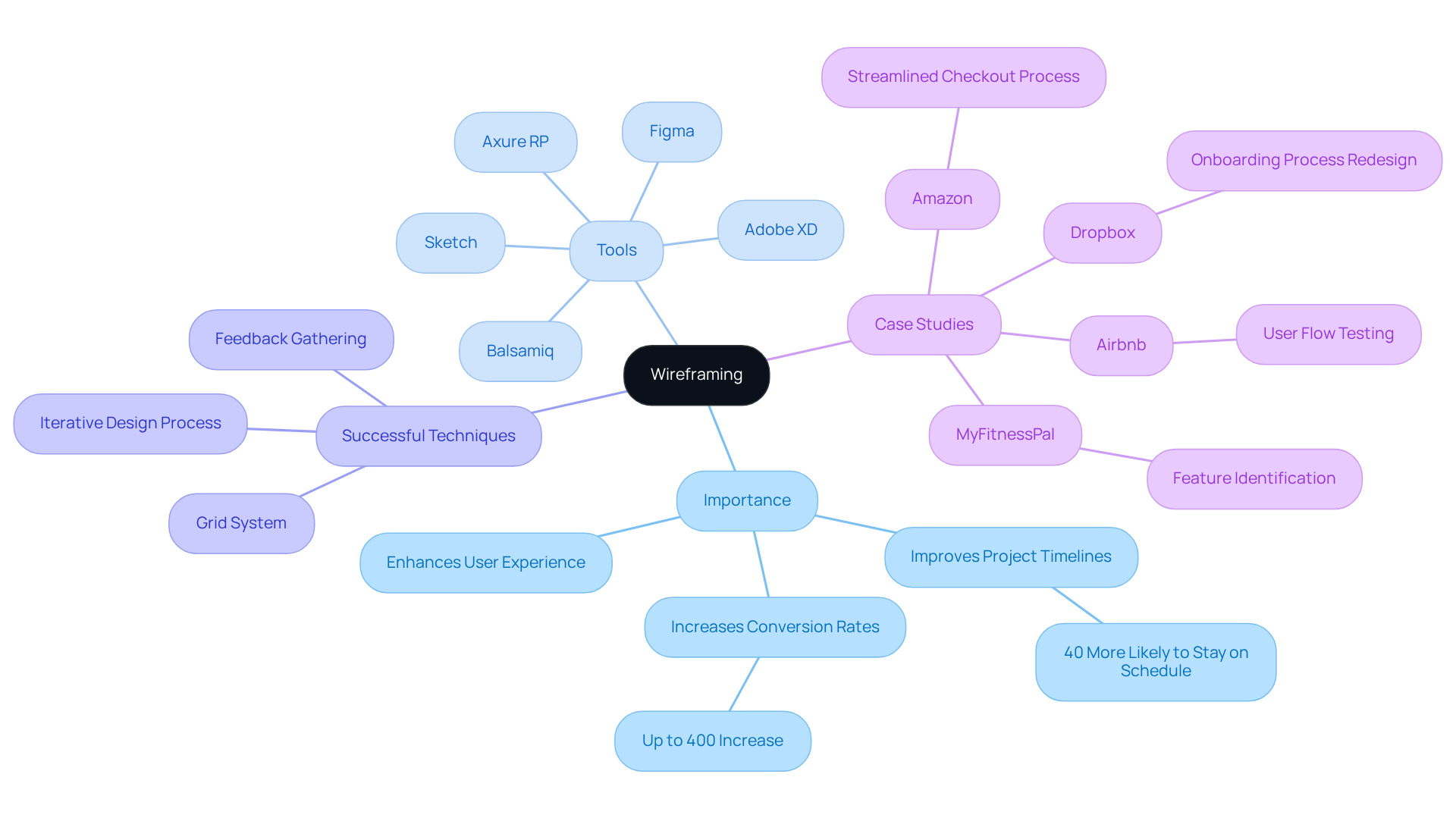
Usability Testing: Ensuring Products Meet User Expectations
Usability testing is a vital process that involves observing real users as they interact with a product. This approach allows new businesses to identify and address the challenges their customers face. Various forms of testing exist, such as:
- Moderated sessions
- Remote testing
- A/B testing
By collecting both qualitative and quantitative data, startups can refine their designs to align more closely with customer expectations. Research shows that companies that invest in iterative usability testing see an average revenue growth of 10% to 15% compared to their competitors (source: Revenue Growth through Iterative Usability Testing). Furthermore, effective usability testing can uncover up to 85% of usability issues, leading to significant improvements in engagement and retention rates.
Consider the case study titled 'Impact of UX Research on Conversion Rates.' It revealed that a minor adjustment in the placement of a call-to-action button, informed by participant feedback, led to a remarkable 20% increase in conversion rates. Additionally, ensuring consistency in appearance across devices resulted in a 15% reduction in cart abandonment rates, underscoring the tangible benefits of usability testing. As we look ahead to 2025, current best practices emphasize the importance of continuous usability testing and user-centered approaches. This ensures that products not only meet but exceed expectations. By prioritizing usability testing, tech companies can enhance their ux services to foster a more engaging experience, ultimately boosting customer loyalty and sustainable growth. To implement usability testing effectively, new businesses should consider organizing regular feedback sessions and refining their strategies based on genuine user interactions.
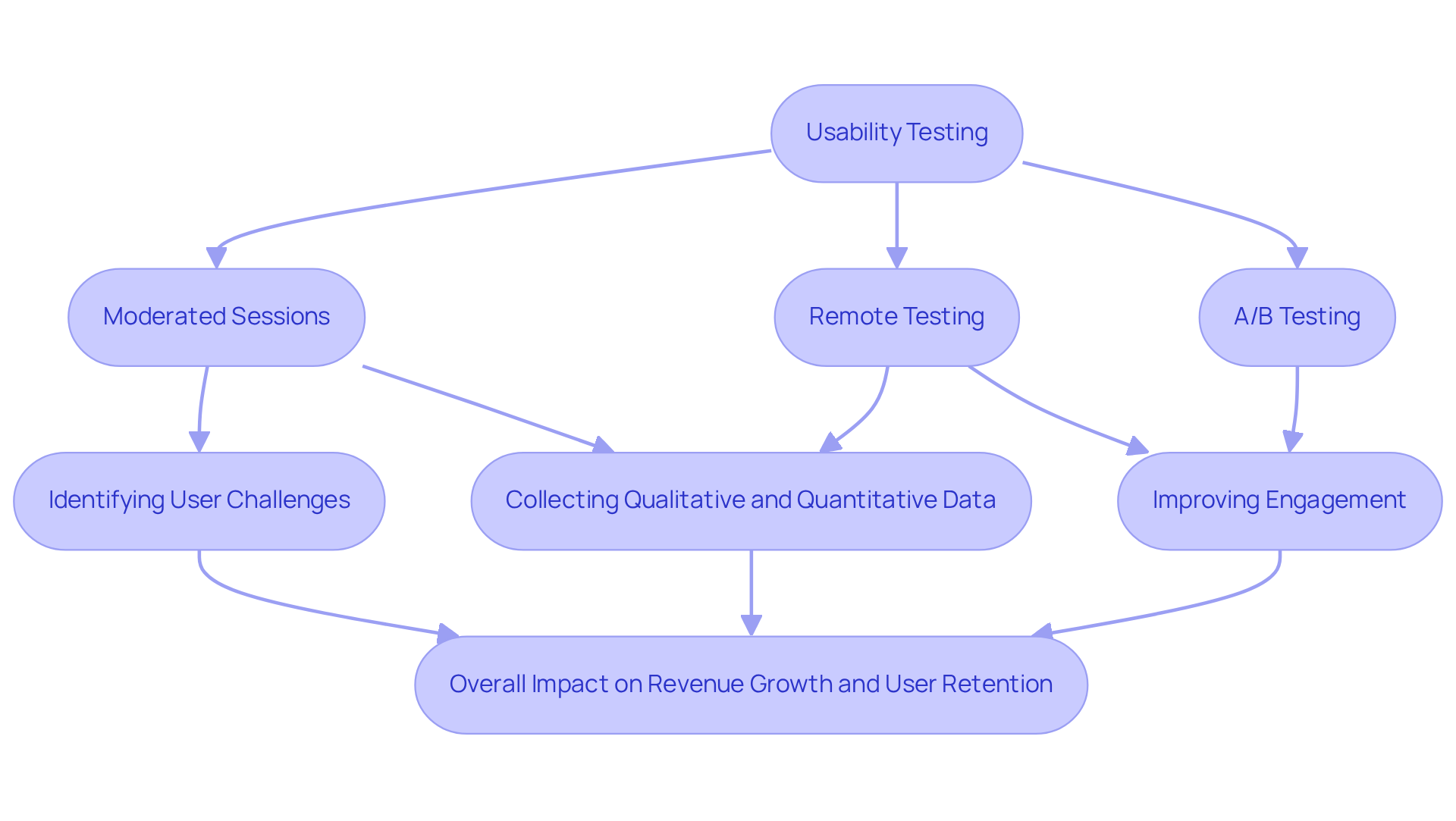
Prototyping: Creating Interactive Models for Feedback
Prototyping can feel daunting for many in the UX development journey, as it involves crafting interactive models that closely mimic participant experiences. These prototypes can range from simple paper sketches to intricate digital interfaces, and it's essential to involve individuals in evaluating them. This engagement allows startups to gather invaluable insights, which are crucial for refining concepts and ensuring that the final product truly meets the needs and expectations of users.
Research shows that products with three or more prototype iterations are 50% less likely to fail, highlighting the importance of thorough testing. Additionally, 85% of successful creative projects begin with a comprehensive research phase, often incorporating prototyping as a key component.
Different types of prototypes serve unique purposes:
- Low-fidelity prototypes are excellent for initial brainstorming and validating concepts.
- High-fidelity prototypes provide a more accurate representation of the final product, facilitating detailed testing with participants.
This iterative approach not only improves usability but also aligns product development with business objectives. Companies that prioritize UX services often experience a remarkable increase in customer loyalty and revenue—up to 240%—demonstrating the profound impact of thoughtful design.
Incorporating client feedback during the prototyping phase is vital; 74% of organizations recognize the effectiveness of UX services in guiding decision-making. By embracing prototyping, new ventures can significantly reduce development costs—by as much as 33%—while also enhancing overall user satisfaction. This ultimately leads to higher conversion rates and stronger customer loyalty. As the landscape of UX development continues to evolve, staying attuned to the latest prototyping trends and techniques will be essential for tech startups striving to enhance their UX services and create meaningful digital experiences.
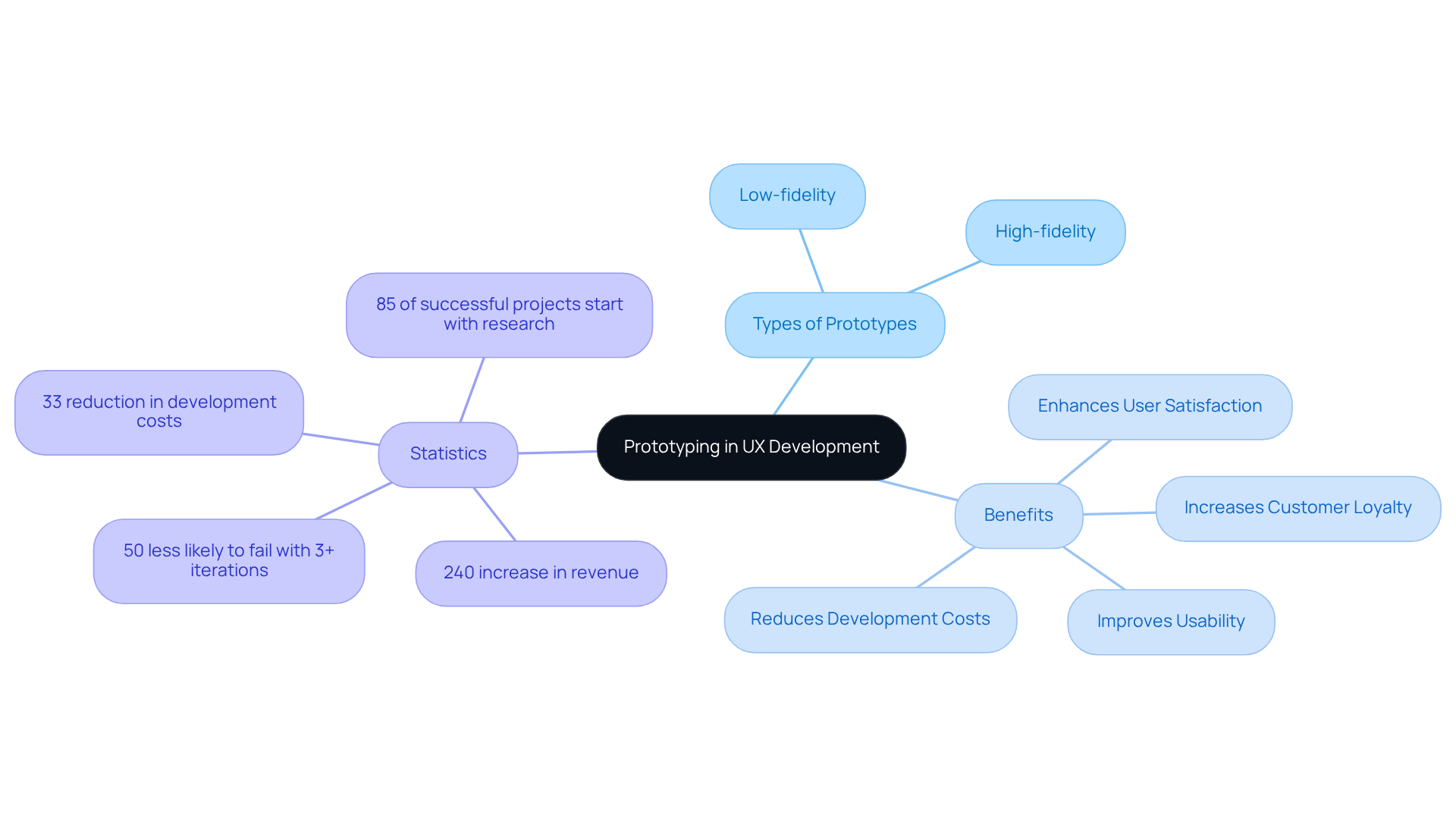
UI Design: Crafting Aesthetic and Interactive User Interfaces
Creating a user interface (UI) can feel overwhelming, especially for startups that are utilizing ux services to make their mark. The visual elements of a product—layout, color schemes, typography, and interactive components—are not just details; they form the heart of how users experience your brand through ux services. When you focus on ux services for effective interface creation, you do more than enhance aesthetic appeal; you ensure intuitive navigation, which is vital for user satisfaction. Startups that prioritize both design and functionality can craft interfaces that not only delight users but also foster deeper engagement by utilizing effective ux services.
Consider this: firms that invest in high-quality aesthetics often see remarkable increases in conversion rates. Well-crafted interfaces can enhance conversions by as much as 200%. It's crucial to understand that aesthetic factors matter; studies reveal that 52% of individuals cite aesthetics as the primary reason for not returning to a website. Furthermore, a staggering 94% of first impressions are design-driven, highlighting the importance of a visually appealing interface in building credibility and trust.
The role of interactive design elements cannot be understated when it comes to engaging your audience. Customized calls-to-action can convert 202% more effectively than standard versions, illustrating how tailored experiences resonate with users. New businesses that embrace effective UI strategies often report improved customer retention and loyalty; even a modest 5% increase in retention can lead to profit growth of 25% to 95%.
Successful tech startups have harnessed these principles to enhance their ux services and elevate their user interfaces. For instance, Staples experienced a remarkable 500% increase in online revenue following an overhaul that emphasized UX services, showcasing the tangible benefits of investing in user-focused approaches. Additionally, design-led companies have outperformed the S&P by 228% over the past decade, underscoring the long-term financial advantages of prioritizing UI design. As the digital landscape evolves, it’s essential for new businesses to recognize that effective ux services include a well-crafted UI, which is not merely an aesthetic choice; it’s a strategic necessity for driving engagement and achieving lasting success. Remember, you’re not alone in this journey—embracing these insights can lead to a brighter future for your startup.
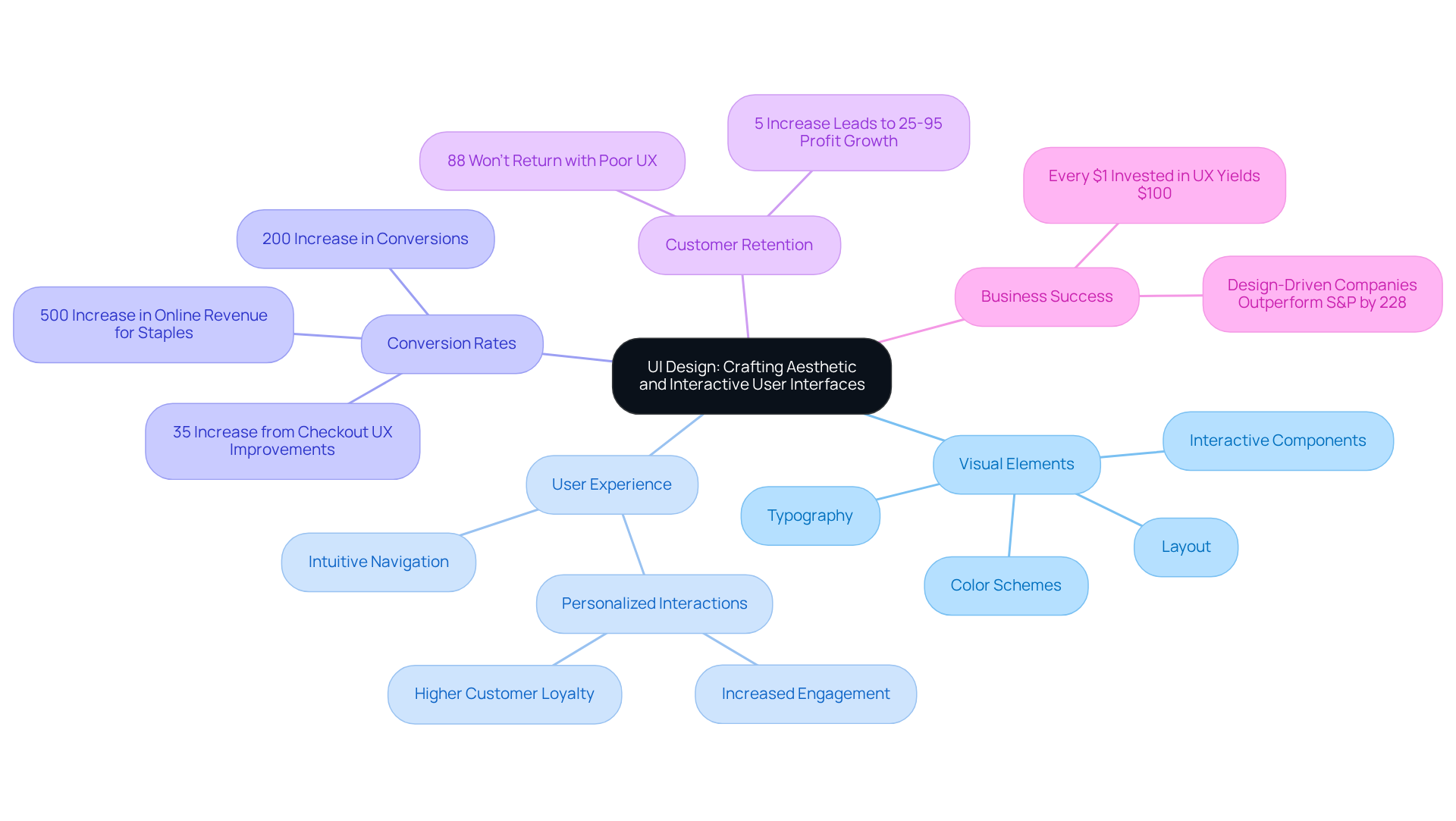
Content Strategy: Guiding Users with Clear and Engaging Information
A clearly outlined content strategy is crucial for technology enterprises, as it involves the careful planning, creation, and management of content that aligns with both audience needs and business goals. This strategy includes defining the tone, style, and messaging of the content presented within the product. By providing clear and engaging information, startups can effectively guide individuals through their journey, facilitating goal achievement and significantly enhancing overall satisfaction.
Data underscores the importance of content strategy in user engagement: businesses that prioritize a coherent content strategy see a notable increase in user retention and satisfaction. For instance, 86% of consumers are willing to pay more for a seamless experience, highlighting the direct correlation between effective content delivery and customer willingness to invest (UserGuiding).
Successful implementations of content strategies in technology ventures demonstrate tangible benefits. For example, companies that have integrated user feedback into their content planning have reported a 25% increase in customer retention, showcasing how aligning content with user expectations can drive loyalty (UserGuiding). Furthermore, new businesses that employ data-driven methods in their content strategy are 23 times more likely to gain new customers, emphasizing the competitive edge of a strong content framework (Forrester).
To create an effective content strategy, startups should focus on understanding their target audience through research and analytics. This involves identifying individual pain points, preferences, and behaviors to tailor content that resonates with them. Consistently refreshing and enhancing content according to feedback and engagement metrics is also vital, ensuring that the strategy evolves alongside audience needs and market trends. Moreover, guaranteeing that content is accessible to everyone is essential, as almost 16% of the global population has disabilities, and 90% of websites are unreachable for them.
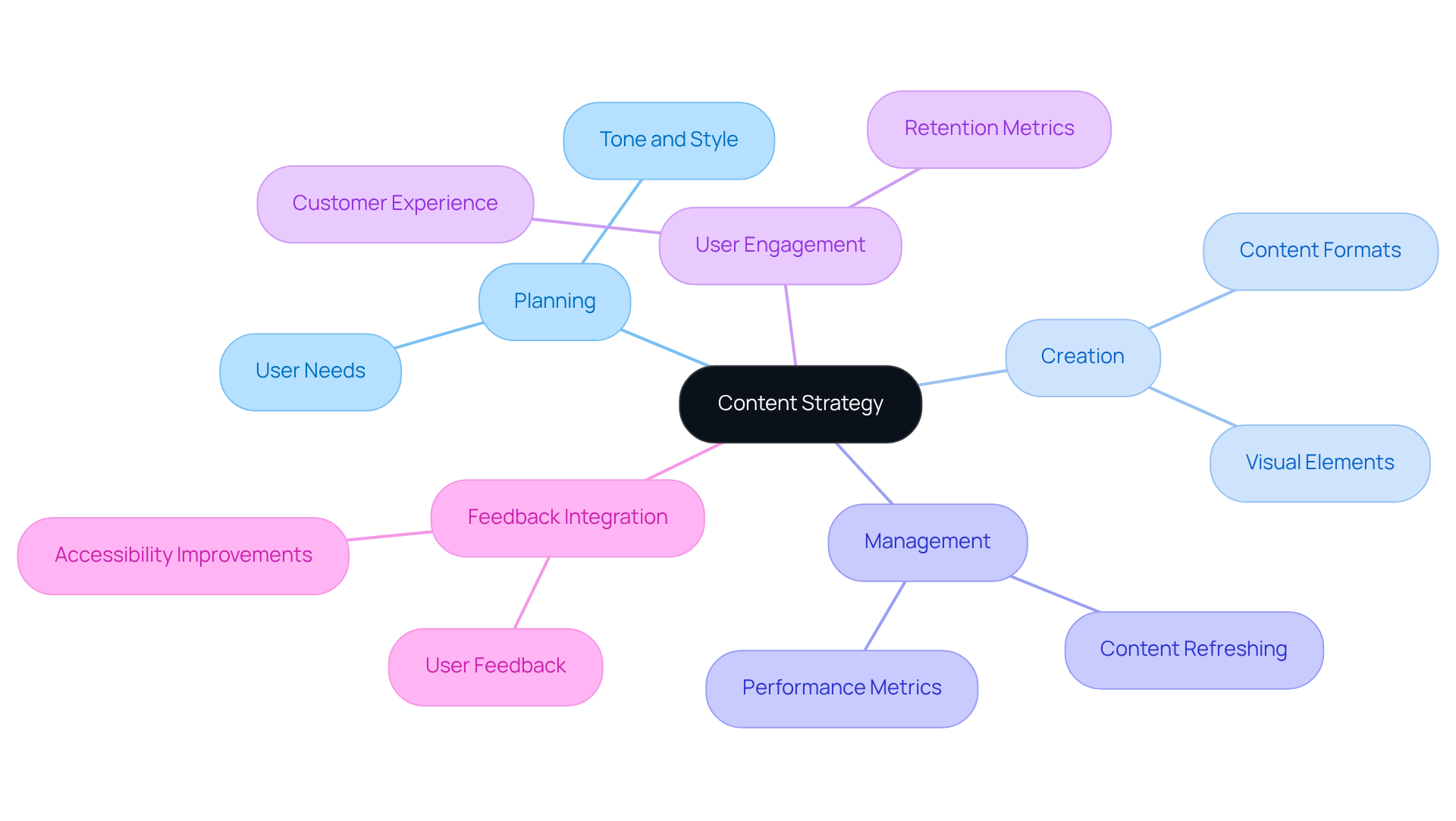
Accessibility Design: Making Products Usable for Everyone
Accessibility planning is essential for creating products that truly cater to individuals with disabilities. It encompasses vital elements such as:
- Color contrast
- Keyboard navigation
- Screen reader compatibility
When new companies embrace best practices in accessibility, they promote inclusivity, allowing everyone to engage with their offerings effectively. However, the reality is stark: studies show that 83% of e-commerce platforms face accessibility challenges that can hinder or greatly affect tasks for individuals. This underscores the urgent need for new businesses to prioritize accessibility in their UX services approach.
Moreover, companies that focus on accessibility are four times more likely to achieve superior shareholder returns. Digital products that comply with WCAG 2 are anticipated to outperform their market competitors by an impressive 50%. As the digital landscape evolves, incorporating accessibility into product design is not just about compliance; it represents a strategic advantage that can significantly enhance engagement and loyalty.
By ensuring that digital products are accessible, new businesses can tap into a market with over $1.9 trillion in disposable income controlled by individuals with disabilities. This not only expands their reach but also amplifies their impact in the marketplace. Additionally, with 8,227 lawsuits filed in federal court under Title III of the ADA in 2023, addressing accessibility issues is not merely a moral obligation; it is a critical business strategy to mitigate legal risks. Together, let’s work towards a more inclusive digital world.
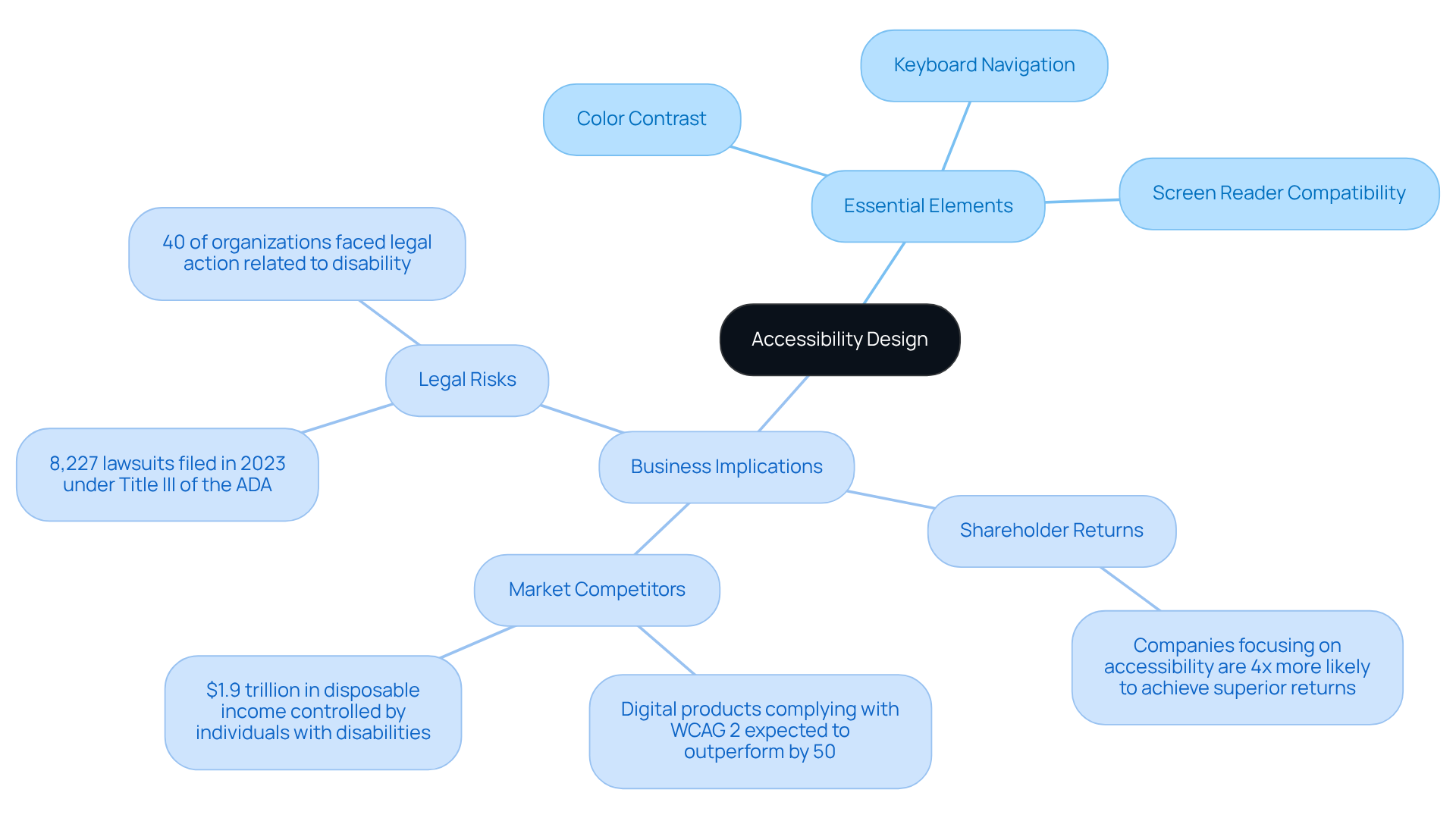
Performance Analytics: Refining UX Strategies with User Data
Performance analytics are essential in understanding interactions and behaviors, offering vital insights into how products are used. New businesses often face the challenge of enhancing their UX services, with essential metrics such as engagement levels, conversion rates, and drop-off points illuminating the path forward. For instance, businesses that prioritize UX can see their conversion rates soar by as much as 400%. A thoughtfully crafted interface can elevate conversion rates by up to 200%, underscoring the importance of making data-informed decisions.
By delving into consumer behavior metrics, new businesses can identify friction points and improve their digital interactions. It’s disheartening to know that 88% of visitors are less likely to return to a website after a negative experience. Additionally, 86% of customers will abandon a brand they once trusted after just two unsatisfactory interactions. These statistics highlight the pressing need for continual improvement. Effective performance analytics strategies empower new ventures to monitor engagement and adapt their offerings, fostering higher retention rates and greater customer satisfaction.
Many successful tech ventures have harnessed performance analytics to refine their UX services. A compelling case study revealed that a well-designed user interface can boost conversion rates by up to 200%. This clearly illustrates the direct link between financial success and investing in UX services, making it crucial for startups to utilize robust analytics tools. Moreover, improving UX services to increase customer retention by just 5% can yield a 25% increase in profit, further emphasizing the financial advantages of investing in UX services.
Key metrics for monitoring engagement include session duration, bounce rates, and conversion rates. Startups should focus on these indicators to assess the effectiveness of their UX services strategies. As tech founder Daniel Kodam wisely states, "UX/UI is the backbone of a strong application," reinforcing the necessity of a solid analytical foundation to drive satisfaction and business success. Furthermore, insights from Jared Schwitzke highlight RNO1's design-first approach, aligning with the emphasis on UX and the importance of investing in customer satisfaction.
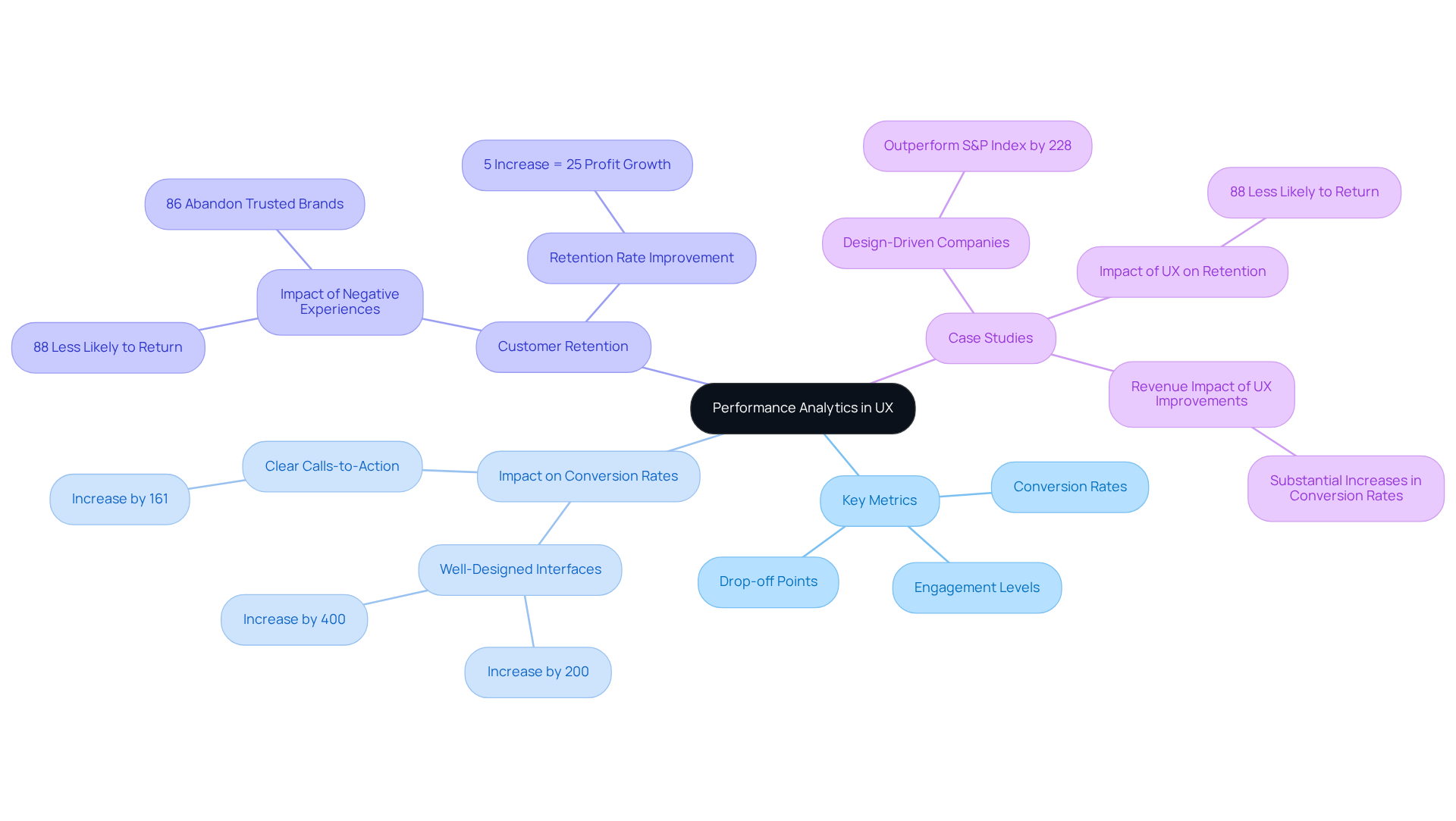
Ongoing UX Consulting: Adapting to User Needs and Market Trends
Continuous UX services consulting is crucial for technology ventures. Many founders struggle with aligning their products to meet the ever-evolving needs of their clients and the market. This ongoing process involves:
- Regular usability testing
- Participant feedback sessions
- Performance reviews
By placing a strong emphasis on continuous improvement, startups can adapt their offerings and UX services to meet these changing demands, which is vital for long-term success. It’s important to recognize that a seamless user experience can lead to conversion rates soaring by up to 400%. This statistic underscores the necessity of UX services that resonate with users on a personal level. Furthermore, it’s disheartening to note that 88% of individuals are unlikely to return to a site after a negative experience, highlighting the importance of maintaining high UX standards.
Successful stories, like that of Housing.com, which saw a 20% increase in feature adoption following a redesign of its search functionality, illustrate the real benefits that come from ongoing UX services. As Ketan Rajput wisely states, 'Human-centered design places end clients at the core of the design process,' reinforcing the need for new ventures to invest in continuous UX services. By regularly scheduling usability testing and user feedback sessions, startups not only boost user satisfaction but also cultivate brand loyalty, ultimately driving growth and success in a competitive landscape. Let’s embrace the journey of continuous improvement together, ensuring that we create experiences that truly connect with our users.
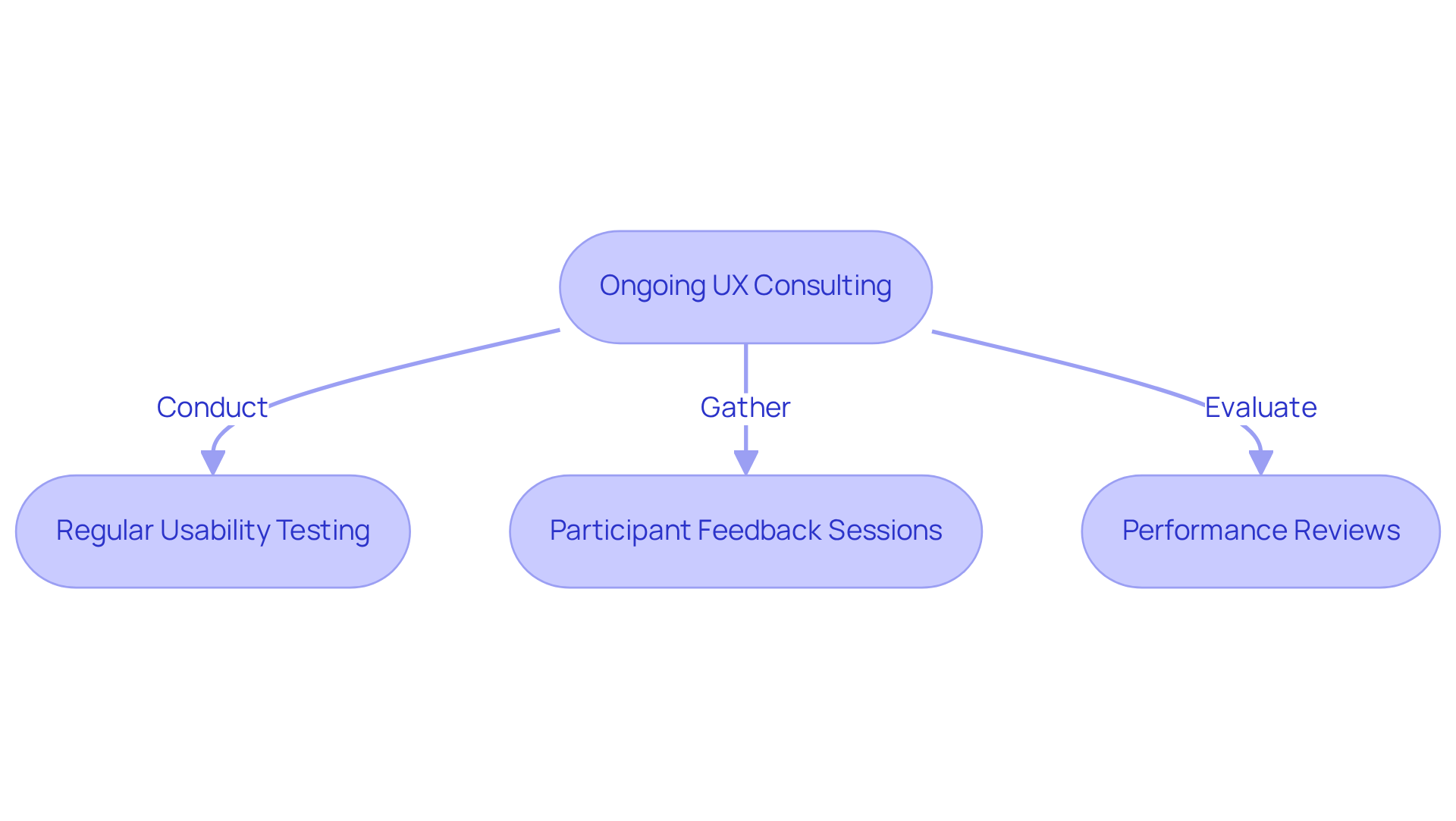
Conclusion
Investing in essential UX services is a pivotal strategy for tech startups striving to flourish in a competitive digital landscape. These services, encompassing comprehensive branding and digital product design, along with ongoing UX consulting, are not just enhancements; they are fundamental components that drive user engagement, customer satisfaction, and ultimately, business success. By placing user experience at the forefront, startups can create products that resonate deeply with their audience, fostering increased loyalty and revenue growth.
Throughout this article, we have explored key insights that illustrate the undeniable impact of effective UX services. We highlighted the significance of user research in understanding customer needs, the role of wireframing in visualizing product functionality, and the benefits of usability testing in refining designs. Furthermore, elements such as:
- Prototyping
- UI design
- Content strategy
- Accessibility design
- Performance analytics
- Continuous consulting
are all crucial in crafting a seamless user experience. Real-world case studies, like those of JobNimbus and Housing.com, reinforce how these practices can lead to remarkable improvements in user engagement and satisfaction.
In a world where user expectations are continually evolving, embracing these UX services is not merely an option but a necessity for tech startups. By adopting a user-centered approach and leveraging data-driven insights, businesses can create meaningful digital experiences that not only meet but exceed customer expectations. The journey toward exceptional user experience is ongoing, and we encourage startups to remain adaptable, seeking continuous improvement to ensure lasting success in the ever-changing market landscape.
Frequently Asked Questions
What services does RNO1 offer for technology companies?
RNO1 offers comprehensive branding, digital product design, user interaction (UX) creation, user interface (UI) design, and performance marketing strategies tailored specifically for technology companies.
Why is investing in UX services essential for technology companies?
Investing in UX services is essential because companies that prioritize design can generate significantly more revenue, with studies indicating up to 32% more revenue and potential conversion rate increases of up to 400%.
Can you provide an example of a company that benefited from UX design?
JobNimbus improved its app ratings from 2.5 to 4.8 after a redesign, demonstrating the transformative power of effective UX design. Similarly, Housing.com saw a 20% increase in feature adoption after enhancing their search capabilities.
What is the role of user research in product development?
User research involves gathering insights about potential users through surveys, interviews, and observational studies, which helps businesses understand customer pain points and preferences, leading to better product alignment and customer satisfaction.
How does audience research impact customer satisfaction?
Organizations with strong research practices are 1.9 times more likely to report improved customer satisfaction, highlighting the importance of understanding customer needs in achieving success.
What financial benefits can businesses expect from prioritizing client satisfaction?
Businesses that focus on client satisfaction can anticipate a significant return on investment (ROI) for usability and client interaction, projected to be 9,900 in 2024.
What is wireframing and why is it important for tech startups?
Wireframing is the process of creating low-fidelity sketches or digital representations of a product's layout and functionality. It is important because it helps teams visualize the interface early, promoting feedback and ensuring alignment on the product's direction.
What benefits does incorporating wireframing provide?
Projects that incorporate wireframing are 40% more likely to stay on schedule, and effective wireframing can lead to significant increases in user retention and conversion rates.
What tools can assist with the wireframing process?
Tools such as Sketch, Adobe XD, Figma, Axure RP, and Balsamiq can simplify the wireframing process with features like drag-and-drop functionality and collaboration capabilities.
Can you give examples of companies that successfully used wireframing?
Amazon improved its checkout process through effective wireframing, resulting in a better user experience. Similarly, Airbnb used low-fidelity wireframes to gather early feedback, leading to a user-centric design that enhanced overall satisfaction.




